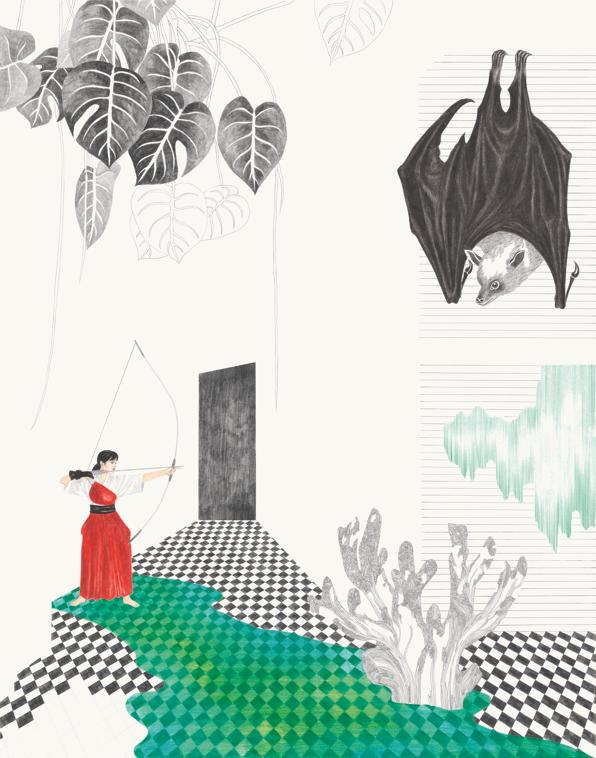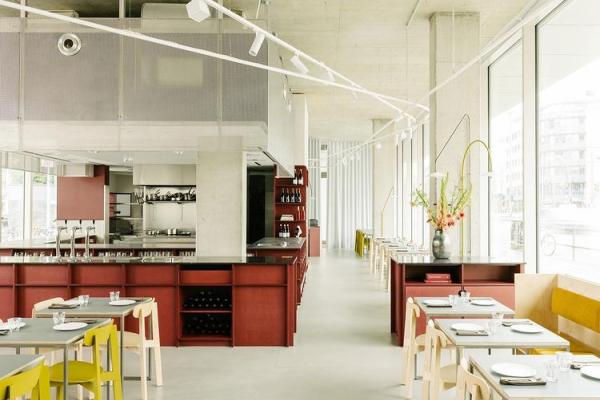Modern european cuisine
URBANLANDSCAPES
URBANLANDSCAPES
With her current exhibition Urbanlandscapes, Nikola Röthemeyer has initiated two new groups of works. Her urban landscapes, which combine nature—in the form of people, plants, and animals—and architecture together, provide the exhibition with its title. Her Innerlandscapes make up the second group of works, in which she employs a new approach to break apart and transform already familiar forms and elements. Rounding off the series is a large, room-scale drawing and a number of exploratory sketches (“Searchdrawings”) that shed light on her working process.
The title of the series, with its varying letter heights and the combining of two words into one, gives us an inkling of what’s to come. The Urbanlandscapes function as tableau-like views into a realm of vanishing architectures. In the initial composition, Nikola Röthemeyer lays everything out, only to eliminate all non-essential elements in the next phase, often ultimately choosing surface area over lines. The viewer senses the function served by negative spaces created without lines, but a shift from graphic finesse to artistic reduction alters the impression of space. As one line after another disappears, so do interior and exterior walls, ceilings, and corridors. The highly subtle edge of a cloud, however, ensures these remain visible.
In the series, Röthemeyer’s protagonists undergo a shift from quiet contemplation to active determination. Her figures, which she poses like actors playing various roles, noticeably populate the background and are joined by even far more visibly prominent animals. Appearing among them are old acquaintances, such as the deer, but also new creatures, like an inquisitive manatee or two squabbling cranes.
The Urbanlandscapes examine in particular the interpenetration of nature and the anthropogenic consequences of this. The process of reconquest plays a decisive role here. This is apparent in both the scale of the figures and the way in which the figure dissolves into the background, as in Urbanlandscape no 5 (hummingbirds). Accordingly, her focus is a general reassessment of the meaning of the figure. Moreover, she elevates the theme of interpenetrating interior and exterior spaces from her series of collages to a purely graphic level.
Nikola Röthemeyer’s Innerlandscapes developed out of her working with Rorschach-like inkblots. As opposed to her Urbanlandscapes, she starts drawing without a specific image idea. The drawing is allowed to develop freely on paper and thus depicts an “inner landscape.” Despite the necessity for control, she is cognizant of the constant tension and critical balance between logic and intuition, between the right and left sides of the brain. Starting by outlining the inkblot and creating textures with the ink, a fantastic interior landscape begins to take shape on paper. The elements of the drawing are created via spontaneous interactions and generate a fusion of information. Röthemeyer employs contrasting colours to break apart the mirrored inkblot form. Once again spaces play an important role, but unlike before, Röthemeyer fills these in, interleaving them with great skill, one fragment with the other. In the process she tests the limits of her own imagination by allowing the work to develop freely and spontaneously. The drawings can also begin along all four edges and move toward the center of the paper. Hence, a deer near the upper right edge of Innerlandscape no 1, with its whirl of antlers turns and peers towards the center of the image. The Innerlandscapes seem to grow layer by layer, thus forming the exact counterbalance to the intrinsically related series of Urbanlandscapes. Whereas the Urbanlandscapes portray scenic moments, the Innerlandscapes are contemplative spaces where time stands still.
Nikola Röthemeyer was born in 1972 in Braunschweig. She studied graphic design at Burg Giebichenstein, University of Art and Design Halle, illustration at École des Arts Décoratifs in Strasbourg, visual design at Glasgow School of Art, and visual communication at Weißensee Academy of Art Berlin. From 2002 to 2003, Nikola Röthemeyer was a master student in the drawing class of Nanne Meyer. In 2017, she received the Mathilde-Planck Fellowship to teach drawing at the Pforzheim School of Design.
Her work is part of the German Bundestag collection in Berlin, the Columbus Art Foundation in Ravensburg, and numerous private collections. Drawings by Nikola Röthemeyer have been presented in individual and group exhibitions in museums and art venues across Germany and abroad, including Kunsthalle Ravensburg, The Model in Sligo, Magazin4 at Bregenzer Kunstverein, the gallery of the Deutsche Gesellschaft für Christliche Kunst in Munich, Kunsthaus Kloster Gravenhorst, the Haus für die Kunst in Hasselbach, and national and international galleries.













